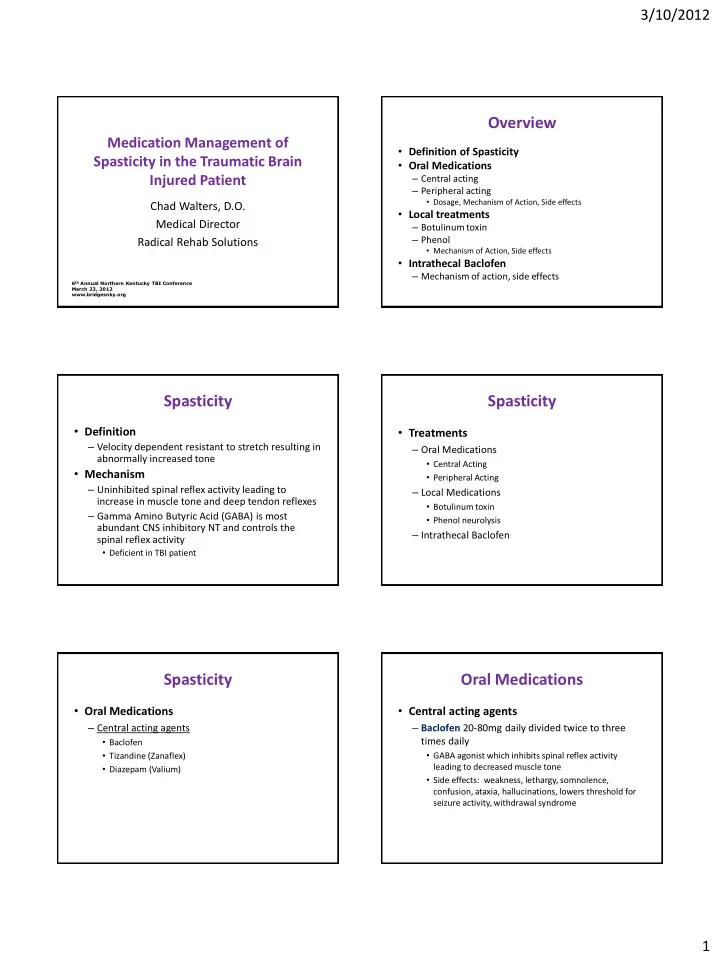

3/10/2012 Overview Medication Management of • Definition of Spasticity Spasticity in the Traumatic Brain • Oral Medications Injured Patient – Central acting – Peripheral acting • Dosage, Mechanism of Action, Side effects Chad Walters, D.O. • Local treatments Medical Director – Botulinum toxin – Phenol Radical Rehab Solutions • Mechanism of Action, Side effects • Intrathecal Baclofen – Mechanism of action, side effects 6 th Annual Northern Kentucky TBI Conference March 23, 2012 www.bridgesnky.org Spasticity Spasticity • Definition • Treatments – Velocity dependent resistant to stretch resulting in – Oral Medications abnormally increased tone • Central Acting • Mechanism • Peripheral Acting – Uninhibited spinal reflex activity leading to – Local Medications increase in muscle tone and deep tendon reflexes • Botulinum toxin – Gamma Amino Butyric Acid (GABA) is most • Phenol neurolysis abundant CNS inhibitory NT and controls the – Intrathecal Baclofen spinal reflex activity • Deficient in TBI patient Spasticity Oral Medications • Oral Medications • Central acting agents – Central acting agents – Baclofen 20-80mg daily divided twice to three • Baclofen times daily • Tizandine (Zanaflex) • GABA agonist which inhibits spinal reflex activity leading to decreased muscle tone • Diazepam (Valium) • Side effects: weakness, lethargy, somnolence, confusion, ataxia, hallucinations, lowers threshold for seizure activity, withdrawal syndrome 1
3/10/2012 Oral Medications Oral Medications • Central acting agents • Central acting agents – Tizanidine 6-36mg daily divided three times per – Benzodiazepines day – Diazepam (Valium) 2-10mg BID to TID – Clonazepam 0.5-2mg BID to TID • Alpha adrenergic agonist which binds to spinal cord • Enhances affinity for GABA in the CNS (brain > SC) receptors inhibiting spinal cord reflexes • Enhances pre and post synaptic inhibition at the SC • Side effects: weakness, sedation, dizziness, dry mouth, • Side effects: Sedation, fatigue, habituation, impairment hypotension of motor recovery • Should only be used in severe cases Oral Medications Local Treatments • Peripheral acting agents • Botulinum toxin – Dantrolene 50-300mg daily divided BID to QID – Type A and B • Phenol • Inhibits Ca release from the sarcoplasmic reticulum which is required for muscle contraction • Side effects: weakness, dizziness, drowsiness, hepatotoxicity Local Treatments Local Treatments • Botulinum toxin • Botulinum toxin – Chemical neurotoxin produced by Clostridium – Onset within 12-72 hours botulinum bacterium – Duration ~ 3 months – Type A (Botox) inhibits release of acetylcholine by – Best results if localization techniques used binding to SNAP-25 receptor on presynaptic • EMG guidance membrane • Ultrasound – Type B (Myobloc) inhibits release of acetylcholine • Electrical stimulation by binding to synaptobrevin receptor on – Dosage differs between Type A and B and is presynaptic membrane physician dependent 2
3/10/2012 Local Treatments Local Treatments • Phenol • Phenol – More challenging than botulinum toxin injections – Chemically destroys the nerve at the – Lower cost neuromuscular junction – Technical issues – Non-selective – Used for large muscle groups only – Causes muscle tissue destruction and atrophy – Onset: Immediate – Duration: 1-36 months – Side effects: Dysesthesias, Marked muscle pain, peripheral edema, extensive motor weakness Intrathecal Baclofen Intrathecal Baclofen • Pros : • GABA agonist – Flexibility in dosing to allow tailoring to patient’s – Decreases neural activity at the spinal cord level needs • Surgically implanted pump in the – Beneficial for UE and LE, large and small muscle subcutaneous tissue in lower abdomen groups – Rarely leads to weakness in unaffected muscles • Rubber catheter that runs from pump to CSF • Cons : at the spinal cord – Surgical procedure – Patient selection must be a careful process – Overdose and Withdrawal syndromes Intrathecal Baclofen Baclofen Overdose • Side effects : • Causes – Hypotonia – Programming errors – Somnolence • Incorrect concentration used – Nausea/vomiting • Large dose increases – Dizziness • Switching from continuous to bolus dosing – Urine retention – Failure to wean oral medications with increases in – Constipation pump dosage – Withdrawal – Overdose 3
3/10/2012 Baclofen Overdose Baclofen Overdose • Hypotension • Treatment • Hypotonia – Emergency – call 911 – Respiratory support – Increased weakness from baseline – Determine cause and reverse • Significant somnolence • Respiratory depression • Death Baclofen Withdrawal Baclofen Withdrawal • Causes • Rigidity/Clonus – Empty pump • Itching without presence of a rash – Pump failure • Hallucinations • Battery expires (5-7 years from implant) • Motor malfunction • Seizures – Catheter problems • Fever/Malignant Hyperthermia • Kinking • Breakage – Temperatures often > 106 degrees • Separation from pump • Occlusion • Migration from CSF space Baclofen Withdrawal Summary • Treatment • Treatment of spasticity requires multidisciplinary approach including PT, OT and medications – IV Benzodiazepines • Selection of medications should be patient • Valium 10mg – Cooling blankets specific depending on co-morbidities and deficits – Dantrolene for malignant hyperthermia • Oral medications should be attempted prior to local or invasive treatments • Good practice to know what medications are used for spasticity, their dosages, mechanisms of action and side effects 4
3/10/2012 References • Braddom, et al. Physical Medicine and Rehabilitation. 3 rd Edition. pp 651-662 • Zafonte, et al. Brain Injury Medicine. pp 615- 651 5
Recommend
More recommend